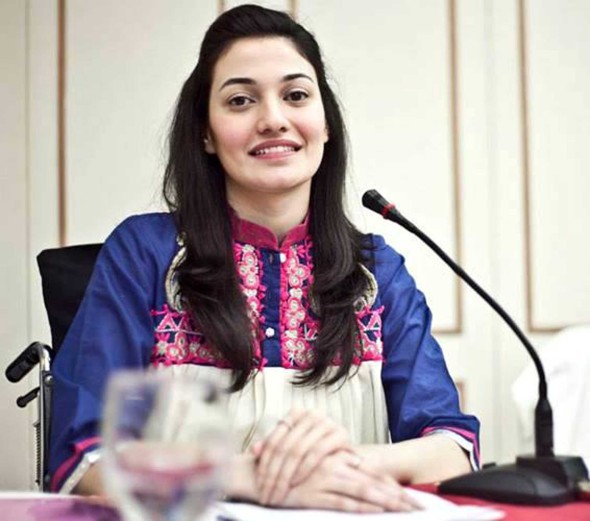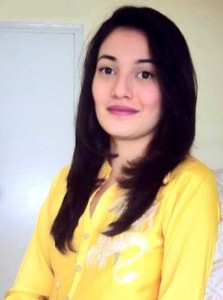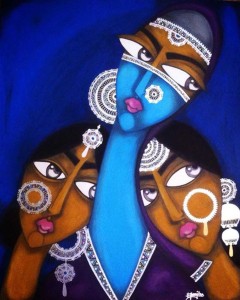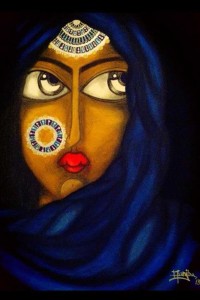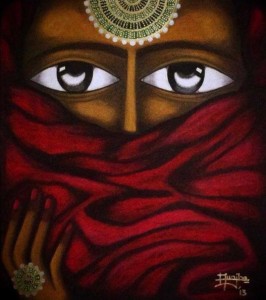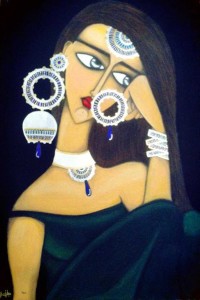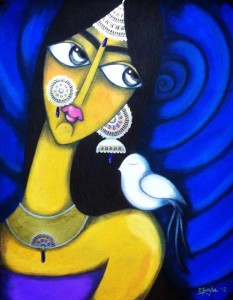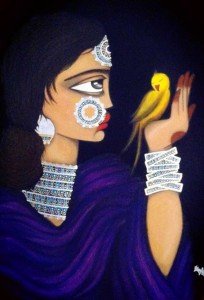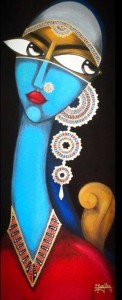A courageous Pakistani woman who turned an adversity into a life-changing opportunity, Muniba Khurram is known as ‘an optimist who is physically challenged and differently able’. Rendered paraplegic after a car accident and wheelchair bound, her spirits and talent is boundless. A full-time mother, an acclaimed artist, content writer and a part-time volunteer social-worker, Muniba is currently running her own brand by the name of ‘Muniba’s Canvas’ and is ready to lead National Forum for Women with Disabilities (NFWWD).With a message of ‘Never Give Up’, Muniba stands strong as an inspirational example of strength and courage – and a woman who dares to be different.
What are your views on the national policy regarding disabilities?
Muniba Khurram: “Personally, I don’t believe in this ‘disability’ quota that is usually talked about because I have never availed of any. Some people do, some don’t. When it comes to me, I want to keep this disability aside. It has been six years now and I believe if you have abilities, why use your disabilities. To me, this is something that was meant to happen, but I have made a conscious effort to not let it affect my entire life.
I have never paid any attention to any national policy, whether it exists or not. People here have no idea as to what disability really is and they have a hard time accepting us the way we are. This, in particular, is our foremost struggle. Some people just get shocked to see a disabled person, people often don’t know how to react to us, whereas others just ignore altogether. These are the kinds of battles we fight every day so talking about national policy doesn’t seem to be of any importance to me. What’s more important is to reach the masses and to make them realise that we are happy the way we are and hence, they should accept us the way we are. Whatever happened to me, it just happened and it has helped me to emerge as a stronger person. I actually started recognising my abilities and my passions after the accident. Earlier on, I had never given any serious thought to being a professional artist. So when we are talking about the government or national policies, I feel it’s just our attempt at imitating the West because people here, have a completely different mentality and stance, eastern if you will, on disability and until we target and fight this mentality, I think it’s useless to talk about policies.
Hence, I joined the National Forum for Women with Disabilities (NFWWD) as a Federal Coordinator where we gather young women with ‘disabilities’, although I don’t really believe in this word. Some of these women are physically challenged, some have their visions impaired while some have lost the ability to hear or talk. The idea is to not demonstrate ourselves as role models but just to give a positive picture that we are confident enough in ourselves to carry ourselves with grace. We are daughters, mothers, wives and daughter-in-law. Most importantly we are women and our own person. I have heard a lot of discouraging things about myself regarding this disability so this forum is also a chance to stand up to such people and invite them to share whatever they have to say and in turn, understand what we are trying to say. We want them to stop attacking our personal lives and instead, understand and appreciate our plans for the future.
Even though I joined this forum as a Federal Coordinator, Akini Naomi from Japan has nominated me to lead this forum on a national and international level which is an absolute honour for me.
Can you give us insight into your collaboration with Imaging One?
MK: “One morning, I was given the chance to be a content writer at Imaging One which was the brainchild of the late Salman Taseer who was the CEO of this company. My friend, who was the technical director for the company, uploaded a status on Facebook stating that they were in need of a content writer and I just commented on that status that I wish I could. The next thing you know she was asking for my number and resume and I had an interview with Salman Taseer himself. I brought along my paintings to the interview, which greatly interested Mr. Taseer and he offered me to be the professional artist of the company whilst joining as a content writer. Hence, I got the opportunity to work for Pakistan’s first official website which we had planned to launch soon before he was tragically killed. It was so sudden and shocking, we couldn’t believe it when we heard it first. He was an exemplary person — a man with a vision. I still remember how he used to push my wheelchair when I used to get too tired and I will always remember him as a fine gentleman, exuding purpose and charisma.”
What is the inspiration behind the creative flare for Muniba’s Canvas?
KB: “My childhood memories are full of drawings and painting here and there. I had to do it because painting and art was my passion but I had never thought of being a professional artist. When I met with my car accident, I was bedridden for an entire year. I could not even sit up and it was a very dark time in my life. So one day my husband got me all these oil paints, a board and some chart paper and insisted that I start drawing again despite my hesitance. However, once I started drawing, I just couldn’t stop. Those were all dark and depressing paintings that I used to make during that time. It was natural I guess. I still clearly remember the pre-surgery and post-surgery pain, even the morphine wouldn’t work sometimes. Being stuck in that room and on the bed, I remember waiting for five in the evening to hear children play outside and the sounds of their laughter used to make me feel alive. That was a very tough time and painting was my escape. Surprisingly, these depressing paintings were the ones that Salman Taseer bought – all of them! He used to say that they may seem depressing to me but for him it was a source of inspiration and courage. Not only did he appreciate my work, but encouraged me to leave everything aside and pursue my passion as a profession, and that is exactly what I am doing now. I owe a lot of credit to where I am now to Salman Taseer’s advice.”
What is the connotation behind the depiction of ethnic jewels in your art?
MK: “I actually designed jewelry for my family and friends for an entire year and the idea of using that in my art instantly clicked. My idea was of a modern Pakistani woman wearing traditional, ethnic jewelry like jhumkas and gulubunds. I was designing jewelry on a regular basis then, so I decided to portray it on a woman who was bold, beautiful and dark — not a conventional beauty. I was, in fact, often questioned as to why do I not paint beautiful women, but my idea has focused on a woman who was daring to be different. She is bold enough to carry herself no matter how she looks. I have had seven to eight exhibitions in the U.S. embassy and I am a member of their panel as well. Foreigners always want to see something representative of the region’s culture and a blend of traditionalism with modernism particularly arrests their attention. In that regard, they felt drawn to my work. Later on, when I joined myartworld.org, the response I received was unexpectedly phenomenal. Everyone admired the colours and the extravagance of the jewels depicted in my art.”
What motivated you to pursue a degree in Fine Arts?
MK: “I was 18 when I got married and I began my bachelors in Fine Arts sometime after my marriage. It was after three semesters into my bachelors when my husband and I met with this car accident. He was completely safe, but I had to face these severe consequences. So for me, art turned into a passion after the accident because it wasn’t just what I loved doing anymore, but also my driving force to emerge as an active individual. It was a medium to express myself. Afterwards, I tried to apply to some major art institutions, but due to my disability, I was refused admission. That was probably the biggest discouragement I faced. I couldn’t be a regular student anyway because there are numerous other medical problems associated with this condition. I even suggested giving me a chance as a private student where I could confer with them on Skype but they weren’t willing to accommodate me. This is why I do not like discussing policies because it’s more important to first focus on the attitudinal barriers and accessibility barriers rather than legislative barriers. For so many years, so many NGOs and organisations have been working and fighting for the rights of disabled individuals.”
What message do you convey to your audience through your work?
MK: “My work is all about hope, inspiration and bringing change. I particularly paint birds and butterflies in my work — butterflies in themselves depict change in society. This change that I focus upon is the change in attitudes that our society desperately needs: we need to keep our hearts and minds clean, and meet everyone with an open heart and an open mind. I intend to convey a clear message that absolutely nothing can stop you if you truly desire something in life. If somebody intends to do good for someone or a cause then let them; do not let your jealousy and insecurities overwhelm the good in you and in others. This reminds me of something my mother has always said to me: even if you are surrounded by unsupportive, negative people, you should always keep your intentions clean; Allah will Himself chalk out ways for you. Hence, just don’t let other people’s opinions and actions define you.
I always attempt to give my clients the best of my artistic abilities. My work is a play on vibrant colours and portrayal of emotions, expression, dreams and aspirations. The message is all about living life to the fullest with strength and courage. I want to leave a resounding impression to people to never give up.
Furthermore, I do wish to give the disabled community in Pakistan a message as well. Let us break the trend of being so conscious of our disabilities that we stop meeting people, stop coming out of our houses and decide to just hide. That is the toughest part to overcome for someone who is in such a situation —to feel acceptance and normality and I have faced this myself. People are not so used to seeing a woman in a wheelchair that some of them just go into shock and don’t even know how to react. But it is up to us how we let it affect us. Until and unless, we in ourselves are not confident enough, people will have a hard time accepting us as well. This is partly why I am on the road with my son all the time. I take him wherever he wants to go, whether it’s the mall or a park. I go to Fun City and play games with him just so my son never feels that I am any less of a ‘normal’ mother. This one time I was playing the ball with him when he insisted that I to kick the ball. I kept telling him that I couldn’t and eventually broke down crying. So he hugged me and consoled me by saying that it was alright and we could just play catch the ball. In that one moment he left me shattered. So he does become my weakness sometimes but he is also my strength. He is everything to us.”
You have emerged as an inspiration for your perseverance and talent. Who inspires you and may have been your role model?
MK: “Without missing a single heartbeat, I will have to say Sarmad Tariq. He has been a quadriplegic since the age of 15 after a swimming accident, but he taught me how to live a life beyond limits. I call him my Guru. He is my mentor, my friend, my guide. Sharing the same injury, we discuss everything and I can share all my fears and pains with him. He has touched and changed the lives of so many, being a motivational speaker, life coach and writer, that it’s overwhelming. I often tell him that when he talks or counsels, he has no idea how he is inspiring those around him. I have always felt that whatever he says should be written in gold! He not only has great management skills, but is a also great human being. Alongside his wife, Zehra Baji, they make a perfect team for all the good work that they are doing. His sole aim is to make people realise the importance of positivity in their life and that’s how I learnt to finish everything I start. I am always on time for my meetings and I make sure to submit my assignments on time just so nobody ever gets to say to me that I couldn’t do something due to my disability. I have to fight for this everyday and prove myself doubly.
My mother has been my rock through all of this — an unrelenting support system that got me through everything. She has never cried in front of me despite all the tough times we have faced. In fact, she not only looks after us all — myself, my brothers, my husband and our son, but also buoys our spirits whenever we feel down. She never stops telling me how proud she is of me and that makes me exceedingly happy every time she says that. She has always taught me a person’s positivity repels negative people and that everything happens for a reason.”
Being a flourishing artist, who is your favorite artist?
MK: “I like Thomas Fedro. His modern/pop art is just so full of zing and a lot of bright colours, big features and bold lines. In Pakistan, I absolutely love the work of Saeed Akhtar. His portraits of women with sparkling jewelry have something very enchanting about them and the depth in the eyes of his portraits leaves you mesmerised. It is extremely inspiring and thought-provoking.”
Being a working mother as well, what is a normal day like for you?
MK: “Well, I am an early riser and it takes around two to three hours for me to get ready. Once when I am done with that I completely submerge myself in painting. I sketch and I paint for quite some time till I start getting my calls and rush out to meetings. My evenings are all for my son whether we are playing in the lawn or going to the mall. If I am not painting, then I am just playing with our son. I barely ever watch television or movies because I just don’t have the time. However, yes, I did watch my television appearances and I cringe every time. The hosts become emotional and I just sit there giggling too much!”
Can you share some of your plans for the future?
MK: “I am contemplating leading the National Forum for Women with Disabilities (NFWWD) which will be a huge honour. Once that goes underway, I would definitely approach Tariq Amin and Deepak Perwani for the grooming of all the young women we have gathered through this forum. We desperately need to educate the disabled women in Pakistan on how to groom themselves and carry themselves because that says a lot about being confident in ourselves and towards others. Life is normal, it just depends on us how we see it. So why let our disabilities influence our social lives and how we look? Being in a wheelchair constrains you in a lot of ways when it comes to carrying yourself. For instance, I absolutely love big bags and but I can’t carry them because it is inconvenient to manage the wheelchair alongside a big bag. Since the forum is all about making these women confident in themselves, grooming is definitely the first step.
Our focus will not be on what we can make the government do for us but rather to create awareness among the general masses. There are a lot of women who do not come out of their homes and such women are stigmatised not just by the society but sometimes by their families and spouses as well. I believe that is the worst that can happen to such a person. I am fortunate to have an amazingly supportive husband, but unfortunately, not everyone has that level of support. Hence, we want to be that level of support for them. When a certain person is disabled in any way, the entire family gets disabled in so many other ways, therefore, families need to be counseled and educated as well. Given my situation, I need to have one of my brothers and husband with me at all times to put me in the car or out of it or on the wheelchair so I am dependant that way. This wouldn’t have been possible if they weren’t fully aware and educated on my special circumstances.
We will move forward from here and work towards bringing a change in the general perception hopefully. It is not an easy process to bring awareness and it is an ongoing process to reinforce the perception that we are happy the way we are.”



